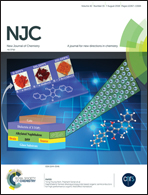An efficient copper catalyzed 3D mesoporous aluminosilicate for the synthesis of dibenzodiazonines in the Ullmann cross-coupling reaction†
Abstract
A series of copper oxide catalysts with different weight percentages, such as 2%, 4% and 6%, supported on three dimensional mesoporous aluminosilicates has been prepared by using a hydrothermal method, and the effects of loading amount on the support, interactions of components and surface properties were systematically investigated using a series of analytical tools like XRD, N2 physisorption, TEM, NH3-TPD and XPS. The catalytic activity of the catalysts was studied in the Ullmann cross-coupling reaction. The characterization results indicate that the synthesized catalyst shows well dispersed CuO species and mild acidic sites, which were responsible for the multifunctional role in condensation and cyclization in the Ullmann cross-coupling reaction. The catalysts react with 3-(2-bromophenyl)acrylaldehyde and benzene-1,2-diamine to form novel N-heterocyclic diazonines, and the selectivity of the products under various conditions implies that 6 wt% CuO/Al-KIT-6 worked as an active catalyst to give 13H-dibenzo[1,4]diazonine derivatives in good yields (95%), which was achieved after 2 h at 80 °C using ethanol as a solvent. The stability of the catalyst was good and it can be recycled up to five times without a noticeable decrease in activity. The catalyst we prepared shows promising performance for the construction of nine membered N-heterocycle rings in an environment-friendly synthetic process.



 Please wait while we load your content...
Please wait while we load your content...